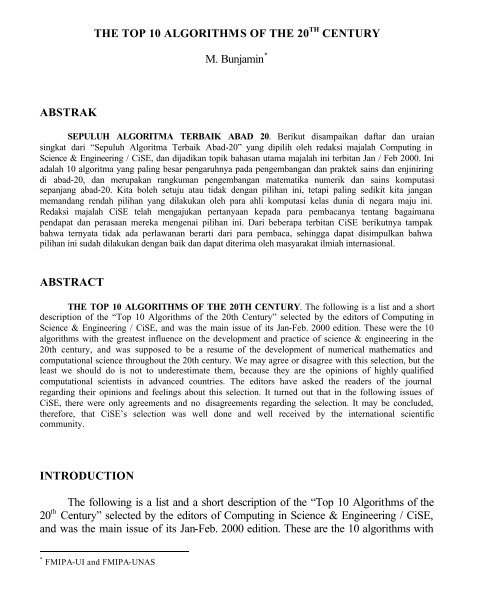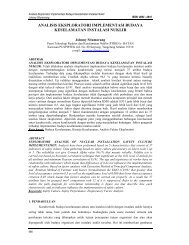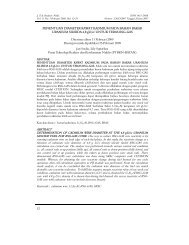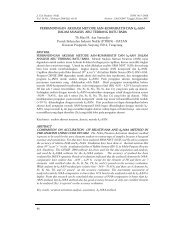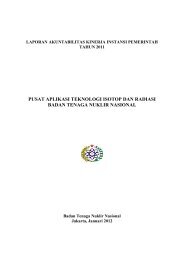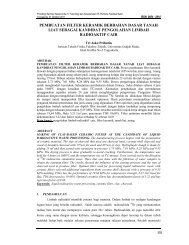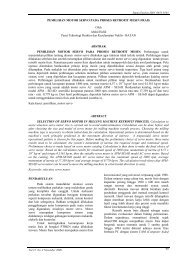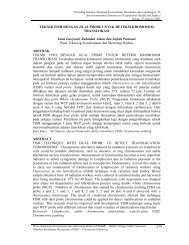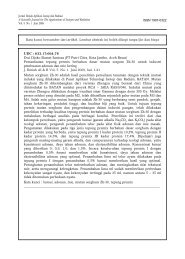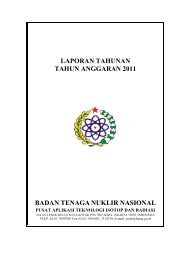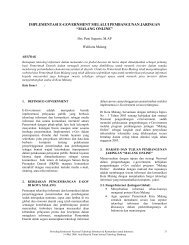THE TOP 10 ALGORITHMS OF THE 20TH CENTURY M ... - Batan
THE TOP 10 ALGORITHMS OF THE 20TH CENTURY M ... - Batan
THE TOP 10 ALGORITHMS OF THE 20TH CENTURY M ... - Batan
Create successful ePaper yourself
Turn your PDF publications into a flip-book with our unique Google optimized e-Paper software.
ABSTRAK<br />
<strong>THE</strong> <strong>TOP</strong> <strong>10</strong> <strong>ALGORITHMS</strong> <strong>OF</strong> <strong>THE</strong> 20 TH <strong>CENTURY</strong><br />
M. Bunjamin *<br />
SEPULUH ALGORITMA TERBAIK ABAD 20. Berikut disampaikan daftar dan uraian<br />
singkat dari “Sepuluh Algoritma Terbaik Abad-20” yang dipilih oleh redaksi majalah Computing in<br />
Science & Engineering / CiSE, dan dijadikan topik bahasan utama majalah ini terbitan Jan / Feb 2000. Ini<br />
adalah <strong>10</strong> algoritma yang paling besar pengaruhnya pada pengembangan dan praktek sains dan enjiniring<br />
di abad-20, dan merupakan rangkuman pengembangan matematika numerik dan sains komputasi<br />
sepanjang abad-20. Kita boleh setuju atau tidak dengan pilihan ini, tetapi paling sedikit kita jangan<br />
memandang rendah pilihan yang dilakukan oleh para ahli komputasi kelas dunia di negara maju ini.<br />
Redaksi majalah CiSE telah mengajukan pertanyaan kepada para pembacanya tentang bagaimana<br />
pendapat dan perasaan mereka mengenai pilihan ini. Dari beberapa terbitan CiSE berikutnya tampak<br />
bahwa ternyata tidak ada perlawanan berarti dari para pembaca, sehingga dapat disimpulkan bahwa<br />
pilihan ini sudah dilakukan dengan baik dan dapat diterima oleh masyarakat ilmiah internasional.<br />
ABSTRACT<br />
<strong>THE</strong> <strong>TOP</strong> <strong>10</strong> <strong>ALGORITHMS</strong> <strong>OF</strong> <strong>THE</strong> <strong>20TH</strong> <strong>CENTURY</strong>. The following is a list and a short<br />
description of the “Top <strong>10</strong> Algorithms of the 20th Century” selected by the editors of Computing in<br />
Science & Engineering / CiSE, and was the main issue of its Jan-Feb. 2000 edition. These were the <strong>10</strong><br />
algorithms with the greatest influence on the development and practice of science & engineering in the<br />
20th century, and was supposed to be a resume of the development of numerical mathematics and<br />
computational science throughout the 20th century. We may agree or disagree with this selection, but the<br />
least we should do is not to underestimate them, because they are the opinions of highly qualified<br />
computational scientists in advanced countries. The editors have asked the readers of the journal<br />
regarding their opinions and feelings about this selection. It turned out that in the following issues of<br />
CiSE, there were only agreements and no disagreements regarding the selection. It may be concluded,<br />
therefore, that CiSE’s selection was well done and well received by the international scientific<br />
community.<br />
INTRODUCTION<br />
The following is a list and a short description of the “Top <strong>10</strong> Algorithms of the<br />
20 th Century” selected by the editors of Computing in Science & Engineering / CiSE,<br />
and was the main issue of its Jan-Feb. 2000 edition. These are the <strong>10</strong> algorithms with<br />
* FMIPA-UI and FMIPA-UNAS
the greatest influence on the development and practice of science & engineering in the<br />
20 th century, and is supposed to be a resume of the development of numerical<br />
mathematics and computational science throughout the 20 th century. We may agree or<br />
disagree with this selection, but the least we should do is not to underestimate them,<br />
because they are the opinions of highly qualified computational scientists in advanced<br />
countries. The editors have asked the readers of the journal regarding their opinions<br />
and feelings about this selection. It turned out that in the following issues of CiSE,<br />
there were only agreements and no disagreements regarding the selection. It may be<br />
concluded, therefore, that CiSE’s selection was well done well received by the<br />
international scientific community.<br />
INTEGER RELATION DETECTION / IRD<br />
For many years, researchers have dreamt of a facility that lets them recognize a<br />
numeric constant in terms of the mathematical formula that it satisfies. With the<br />
advent of efficient IRD algorithms, that time has arrived. Let ( 1, 2,<br />
, n)<br />
x x x L = x be<br />
a vector of real or complex numbers. x is said to possess an integer relation if there<br />
exists integers a i (not all zero), such that L + + a1x1 a2<br />
x2<br />
+ n n = 0 x a . An integer<br />
relation algorithm is a practical computational scheme that can recover the vector of<br />
integers a i (if it exists), or can produce bounds within which no integer relation<br />
exists. These are the activities of computational number theory. The most effective<br />
algorithm for IRD is Ferguson’s recently discovered PSLQ algorithm (Ferguson et al.,<br />
Math. of Computation, Vol. 68, No. 225, Jan. 1999). As an example, the following is a<br />
formula found by PSLQ in 1997 that enable us to compute the n-th hexadecimal digit<br />
of π (CiSE Jan-Feb 2000).<br />
∑ ∞ 1 ⎡ 4 2 1 1 ⎤<br />
π =<br />
k= 0 ⎢ − − −<br />
⎣8<br />
+ 1 8 + 4 8 + 5 8 + 6⎥<br />
.<br />
16<br />
k k k k k ⎦<br />
Another example is the identification of the constant B 3.<br />
54409035955...<br />
, which<br />
3 =<br />
i+<br />
1 = rxi<br />
( 1 xi<br />
is the third bifurcation point of the logistic-map x − ) , which exhibits<br />
period doubling shortly before the onset of chaos. To be precise, B 3 is the smallest<br />
value of the parameter r such that the successive iterates x i exhibit 8-way periodicity
instead of 4-way periodicity. The constants 2 B and 1<br />
Computations using the predecessor of PSLQ found that B 3 is a root of the equation<br />
t<br />
12<br />
−12<br />
t<br />
11<br />
+ 48 t<br />
<strong>10</strong><br />
− 40 t<br />
9<br />
− 193 t<br />
8<br />
+ 392 t<br />
7<br />
+<br />
B may be defined analogously.<br />
44 t<br />
6<br />
+ 8 t<br />
5<br />
− 977 t<br />
4<br />
− 604 t<br />
3<br />
+ 2<strong>10</strong>8 t<br />
2<br />
+ 4913 = 0 .<br />
Using IRD, researchers have discovered many new facts of mathematics and physics,<br />
and these discoveries have in turn led to valuable new insights. This process often<br />
called “experimental mathematics” – namely, the utilization of modern computers in<br />
the discovery of new mathematical principles – is expected to play a much wider role<br />
in both pure and applied mathematics during the 21 st century.<br />
<strong>THE</strong> (DANTZIG) SIMPLEX METHOD FOR LINEAR PROGRAMMING<br />
George Dantzig created a simplex algorithm to solve linear programs for<br />
planning and decision-making in large-scale enterprises. The algorithm’s success led<br />
to a vast array of specializations and generalizations that have dominated practical<br />
operations research for half a century.<br />
In one of the simplex method’s many forms, the LP problem is:<br />
Minimize (w.r.t. x) c x<br />
T subject to Ax = b and x 0.<br />
In practice, the matrix A and the vector b is partitioned so that the LP problem is<br />
written as<br />
Minimize (w.r.t. x) c x<br />
T ,<br />
subject to A1x ≤ b1<br />
A 2x = b2<br />
A3x ≥ b3<br />
x 0<br />
The use of slack and surplus variables can transform the problems from one to the<br />
other form.<br />
Some of the questions when using the simplex method are the following.<br />
• How do we get an initial feasible solution? Or, more importantly, how do we<br />
tell if there are no feasible solutions?
• What happens if the constraints don’t stop the objective from being reduced?<br />
That is, what if the solution is unbounded?<br />
• What happens if several vertices give equal objective values?<br />
Modern textbooks on linear programming solution using simplex method have<br />
abandoned the tableaux and the jargons of the earlier works (Gass, Hadley, Hillier &<br />
Lieberman, etc).<br />
KRYLOV SUBSPACE ITERATION<br />
Many problems lead to large systems of equations of thousands or even millions<br />
of unknowns: electric circuit simulation, magnetic field computation, weather forecast,<br />
chemical processes, semiconductor-device simulation, nuclear-reactor safety analysis,<br />
mechanical-structure stress, and so on. When we face a large system of linear<br />
equations Ax = b, with the N x N matrix A and the N vector b given and the N vector x<br />
unknown, an iterative algorithm such as the successive overrelaxation / SOR method<br />
come to our mind. Another iteration method to help solve similar problems was the<br />
alternating-direction iterative method, which attempted to solve the discretized partial<br />
differential equations over grids in 2-D or 3-D by successively solving 1-D problems<br />
in each coordinate direction.<br />
To start an iteration process, we first try to find a good guess for the solution, for<br />
instance by solving a much easier nearby (idealized) problem. For this purpose,<br />
suppose we approximate the matrix A of the system Ax = b by a simpler matrix K.<br />
Then the iteration process may be formulated as follows: in step i+1, solve the new<br />
approximation x i + 1 for the solution x of Ax = b from Kx i+1<br />
= Kx i + b − Ax i . In<br />
the 1950s Lanczos proposed the idea to keep all approximate computed so far in the<br />
iteration process and to recombine them to a better solution. Lanczos recognized that<br />
the basic iteration leads to approximate x i that are in nicely structured subspaces.<br />
2 1<br />
These subspaces are spanned by r 0 , Ar 0 , A r0<br />
, , A r0<br />
− i<br />
L , where r0 = b − Ax 0 .<br />
Such a subspace is a Krylov subspace of dimension i for A and r 0 . Using Krylov<br />
Subspace Iteration strategy, scientists found several methods such as Conjugate<br />
Gradient Method (Hestenes & Stiefel, 1954), GMRES (Saad & Schultz, 1986), and<br />
Bi-CGSTAB (van der Vorst, 1992), which are useful for solving Ax = b with N > 1<br />
million and A sparse matrix whose elements are mostly zeroes.
<strong>THE</strong> QR ALGORITHM<br />
It is assumed that we all share the view that the ability for fast computation of<br />
matrix eigenvalues is an important tool for modern scientists & engineers. The QR<br />
algorithm is a very satisfactory way, but this success does not mean the QR algorithm<br />
is the last word on the subject. Matrix theory and eigenvalue problems dramatically<br />
increased in importance with the arrival of matrix mechanics and quantum theory, and<br />
further in the development of fluid dynamics, nuclear reactor analysis, geophysics, and<br />
others.<br />
The basic idea behind the QR algorithm is that any N x N real matrix A can be<br />
decomposed into A = A 1 = Q 1 R 1 , Q 1 is orthogonal ��<br />
T<br />
1<br />
−1<br />
1<br />
−1<br />
1<br />
Q = Q , and R1 is<br />
upper-triangular. The next step is to find A2<br />
= R1Q1<br />
= Q A1Q1<br />
, and then<br />
decompose A 2 = Q2R 2 , etc. It can be shown that the sequence A1 , A2 , …<br />
converges to the upper-triangular form of A with eigenvalues in monotone decreasing<br />
order of absolute value down the diagonal. An important property of the QR<br />
decomposition is that it preserves the following properties of a matrix: symmetry,<br />
tridiagonal form, and Hessenberg form. Because of this property, a general matrix<br />
whose eigenvalues have to be found is brought first to a Hessenberg form, say with the<br />
aid of Householder method. Once a matrix is in the Hessenberg form, the QR<br />
transformation is applied iteratively to take it to converge to a form where the<br />
eigenvalues are either isolated on the diagonal or are the eigenvalues of a 2 x 2<br />
submatrix on the diagonal. There are two distinct classes of algorithms for computing<br />
the QR decomposition: Gram-Schmidt algorithms and orthogonal triangularization.<br />
SORTING WITH QUICKSORT<br />
Sorting is one of the most studied problems in computer science, because of<br />
both its uses in many applications and its intrinsic theoretical importance. The basic<br />
sorting problem is the process of rearranging a given collection of items into<br />
ascending or descending order. Although researchers have developed and analyzed<br />
many sorting algorithms, the Quicksort algorithm stands out. Tony Hoare presented<br />
the original algorithm in 1962, and Quicksort is still the best-known practical sorting<br />
algorithm.
<strong>THE</strong> DECOMPOSITIONAL APPROACH TO MATRIX COMPUTATION<br />
There are many matrix decompositions, old and new, and the list of the latter<br />
seems to go on growing. Nonetheless, six decompositions hold the center, because<br />
they are useful and stable. The six decompositions are described briefly below.<br />
1. The Cholesky Decomposition. Given a positive definite matrix A, there is a<br />
unique upper triangular matrix R with positive diagonal elements such that<br />
T<br />
A = R R . In this form, the decomposition is known as Cholesky decomposition.<br />
T<br />
It is often written in the form A = LDL , where D is diagonal and L is a lower<br />
triangular matrix with 1s on the diagonal. Cholesky decomposition is used<br />
primarily to solve positive definite linear systems.<br />
2. The LU Decomposition. Let A is an N x N matrix. There are permutations P and<br />
T<br />
Q such that P AQ = LU , where L is unit lower triangular and U is upper<br />
triangular. The matrices P and Q are not unique, and the process of selecting them<br />
is known as pivoting. LU decomposition is used primarily for solving linear<br />
systems Ax = b, where A is a general matrix. Cholesky and LU decompositions<br />
can be computed with the help of Gaussian elimination.<br />
3. The QR Decomposition. See section IV above.<br />
4. The Spectral Decomposition. Let A is an N x N symmetric matrix. There is an<br />
orthogonal matrix V such that A = VΛV<br />
, where Λ = diag( λ1,<br />
L , λ N ) . If i v<br />
denotes the i-th column of V, then Av i = λi<br />
v i . Thus ( i , i ) v λ is an eigenpair of<br />
A, and the spectral decomposition of A shows the eigenvalues of A along with<br />
complete orthonormal system of eigenvectors.<br />
5. The Schur Decomposition. Let A is an N x N matrix. There is a unitary matrix U<br />
H<br />
H<br />
such that A = UTU , where T is upper triangular and U is the conjugate<br />
transpose of U. The diagonal elements of T are the eigenvalues of A, which, by<br />
appropriate choice of U, can be made to appear in any order. This decomposition<br />
is called the Schur decomposition of A. A real matrix can have complex<br />
eigenvalues and hence a complex Schur form. By allowing T to have a real 2 x 2<br />
blocks on its diagonal that contain its complex eigenvalues, the entire<br />
decomposition can be made real. This is sometimes called a real Schur form. After<br />
a preliminary reduction to Hessenberg form, the Schur form is computed with the<br />
QR algorithm.<br />
6. The Singular Value Decomposition / SVD. Let A be an M x N matrix with M ≥<br />
T ⎛Ó⎞<br />
N. There are orthogonal matrices U and V such that U AV = ⎜ ⎟ , where<br />
⎝ 0 ⎠<br />
( , , ) σ σ Ó = L , ≥ σ ≥L<br />
≥ σ ≥ 0 . This is called the SVD of A. If<br />
diag 1 N<br />
T<br />
σ1 2 N
U A consists of the first n columns of U, we can write A = U A ÓV , which is<br />
sometimes called the singular value factorization of A. The diagonal elements i σ<br />
of S are called the singular values of A. The corresponding columns of U and V<br />
are called the left and right singular vectors of A. There are three classes of<br />
algorithms to compute the spectral decomposition and the SVD: the QR<br />
algorithm, the divide and conquer algorithm, and Jacobi’s algorithm.<br />
<strong>THE</strong> FAST FOURIER TRANSFORM<br />
These days, it is almost beyond belief that there was a time before digital<br />
technology. It seems almost everyone realizes that the data whizzing over the Internet,<br />
bustling through our modems, or crashing into our cell phones is ultimately just a<br />
sequence of 0’s and 1’s, a digital sequence, that magically makes the world the<br />
convenient, high-speed place it is today. Much of this magic is due to a family of<br />
algorithms that collectively go by the name the fast Fourier transform / FFT. The FFT<br />
is perhaps the most ubiquitous algorithm used today to analyze and manipulate digital<br />
or discrete data.<br />
<strong>THE</strong> METROPOLIS ALGORITHM<br />
The Metropolis algorithm has been the most successful and influential of all the<br />
members of the computational species that used to be called the “Monte Carlo<br />
Method.” Traditionally, the Monte Carlo method was applied using the sampling<br />
method called rejection method proposed by Von Neumann. Metropolis et al. in 1953<br />
proposed another method of sampling which is supposed to be much more productive<br />
than the rejection method.<br />
<strong>THE</strong> FORTRAN I COMPILER<br />
The Fortran I compiler was the first demonstration that it is possible to<br />
automatically generate efficient machine code from high-level languages. It has thus<br />
been enormously influential. A very good technique were used in the Fortran I<br />
compiler for the parsing of expressions, loop optimization, and register allocation.<br />
T
FAST MULTIPOLE ALGORITHM<br />
Problems that involve computing the mutual interactions within large number of<br />
particles pervade many branches of science & engineering. When the particles interact<br />
through the electrostatic / Coulomb or gravitational / Newton potentials, the long<br />
range of the resulting forces creates a computational headache. This is because forces<br />
arise for all pairs of charges (or masses) in such a system. Because the number of pairs<br />
increases quadratically with the number of particles N included in a simulation, the<br />
computational complexity of simulations carried out without a well-designed<br />
computational strategy is said to be of order ( N ) . This quickly renders simulation<br />
studies of the so called N-body problem practically impossible as systems increase in<br />
size to levels relevant for realistic problems. This is where the fast multipole algorithm<br />
helps.<br />
CLOSING REMARKS<br />
O 2<br />
1. Out of the <strong>10</strong> algorithms described above, four of them involve properties and<br />
applications of matrices, namely the (Dantzig) simplex method of linear<br />
programming, the Krylov subspace iterations, the QR algorithm, and the<br />
decomposition approach to matrix computation. This fact shows that the role<br />
played by matrices in scientific & engineering computation in the last century was<br />
very important. This role includes the solution of a system of linear equations: Ax<br />
= b, and the eigenvalue problem: Ax = λx, and this seemed to be getting more and<br />
more important in the future, especially to meet the future demands to solve linear<br />
equations or eigenvalue problems involving “monster” matrices with N in the<br />
millions (see for example: Davidson, Monster Matrices, Their Eigenvalues and<br />
Eigenvectors, Computers in Physics, 1993, p. 519). The importance of matrix<br />
theory may also be seen from the fact that there is a scientific journal especially<br />
devoted to it: SIAM Journal of Matrix Analysis and Applications.<br />
2. The mathematical models used in scientific & engineering problem solving<br />
consists mostly of linear ODEs, PDEs and integral equation or integrodifferential<br />
equation. When we solve these problems using finite-difference or finite-element<br />
methods, they are converted into a system of linear equations involving matrices.<br />
3. Mathematics, which in the past used to be highly theoretical in character, and<br />
relies completely on deductive reasoning, is now becoming more “experimental”<br />
as shown by the Integer Relation Detection algorithms. Therefore, inductive<br />
reasoning in mathematics is now quite acceptable by most mathematicians.
4. Methods for solving constrained optimization problems such as Dantzig’s simplex<br />
algorithm for linear problems are becoming more and more important because of<br />
the following fact. In order to survive in a very dynamic world with free global<br />
competition, it is demanded from the producers that production and operations<br />
processes be executed with maximum efficiency and productivity, of course<br />
without sacrificing quality of products.<br />
5. Many scientific problems are multidimensional in character, and therefore<br />
deterministic simulations of these systems are not easy. This is where the Monte<br />
Carlo simulation came to the rescue, such as for multidimensional integrations.<br />
Monte Carlo simulation is also absolutely needed to simulate systems, which is<br />
stochastic in character. In all these applications, the Metropolis method is needed<br />
to increase the efficiency of the simulation, without sacrificing the validity of the<br />
conclusions.<br />
6. Molecular dynamics and molecular mechanics simulations are now becoming<br />
more and more important in computational physics, computational chemistry,<br />
computational biology, and computational medicine. To make sure that the<br />
simulation be as close to reality as possible, the scientists demanded that the<br />
number of particles used in the simulation be as big as those occurring in nature.<br />
Therefore the demand for algorithms with higher and higher efficiency is<br />
practically insatiable. This is where the Fast Multipole algorithm plays its<br />
important role.<br />
7. Out of the total of 142 papers cited by the <strong>10</strong> articles, almost 50% were published<br />
after 1990, another almost 50% were published between 1950-1990, and the<br />
remaining 3% were published before 1950. These facts proved that the top <strong>10</strong><br />
algorithms of the 20 th century were mostly developed after 1950, and highly<br />
developed and widely applied in the 1990s. These developments were mostly in<br />
parallel with the development of high-performance computing systems.


